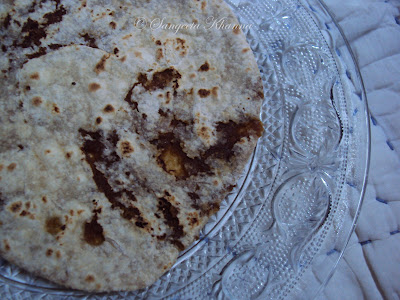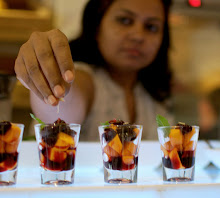Have you ever heard a Bengali talking about food , this is one community madly in love with food . Shopping for food , cooking and serving the food takes a better part of their time and when they start
talking about food they forget about time and space and you feel like being transported into the wonderland of sorshe , kalo jeere , mouri and posto bata ...blah blah blah ..... :)
It was during one such blah blah blah that i realized i would like this jhingey posto which was the hot topic during a club meet . I decided to make it and it became a hot favorite at home . I have never tasted this recipe at any of my bong friends as they tend to overload the dining table with all sorts of meat and fish whenever they invite somebody and the humble veggies are given a miss. For me , it is the simple vegetarian fare of bengali cuisine i like the most and i had to train myself to make those to my taste . Yes , this curry may not be a true blue bengali progeny , because i made it as i overheard it and like the way i made and have been cooking it like this since then..............let's see if you like it and the bong friends can point out where a bengali element is missing ........i don't miss anything in this curry and it is a favorite of both the extremes .... vegetable haters and vegetable lovers in the family..... :)
Jhingey is ridge guard and you have to peel it before using it , the taste of this guard is a bit different from the regular smooth sponge guard and this curry uses the ridge guard only .... though alu posto is quite similar and other veggies can also be experimented upon.
It is a quick recipe once the peeling and grinding has been done. Cooking time is irresistibly low, especially if you like the vegetable almost half cooked like me.
ingredients...
(2-4 servings depending on what side dishes it is served with)
Ridge guards 400 gm
slit green chillies 2-3 (you would like the heat to be mild in this curry so use less green chillies if you otherwise avoid much heat or use the less hot ones)
nigella seeds 1 tsp
mustard oil 1 tbsp
turmeric powder 1/4 tsp (optional, omit if you want a white gravy)
salt to taste
Paste of poppy seeds 3/4-1 cup ....this is white Indian poppy seeds called posto or posta ...
(wash about 1/2 cup poppy seeds through a sieve, let it drain and then make a paste in mixie using some water)
procedure...
Peel the ridge guards first of all. You might like to lightly scrape them if they are tender but the bigger ones need the ridges to be removed using a peeler and most of the skin too. You can retain some of the skin if you like but i usually peel off the skin altogether. Cut about 1.5 inch long pieces first and then slice them in batons lengthwise, making 6-8 long batons out of each piece.
I would like to mention that the cut of the guards makes a lot of difference in the taste and texture of the finished dish.If you cut round and thin slices it releases more water and the vegetable gets very mushy. I have seldom cut a ridge guard in thin slices. For a chana daal or mung daal cooked with this guard, i cut it into dices and that works perfectly well for that. So it is thick (1 cm) batons for this recipe.
Heat the oil in a pan, mustard oil for the authentic bengali thing, and throw in the nigella seeds and wait till they crackle a little. Add the slit green chillies and let them fry and release the heat in oil, just for a few seconds though.
Tip in the chopped ridge guard , add salt, turmeric if using and toss them all. Cover and cook on medium flame till the slices get wilted and release some juices. 5 to 7 minutes to be precise.
This is the time to add the poppy seeds paste , mix well and cook till a gentle boil. The poppy seed paste is added when the ridge guard is almost done. I like the ridge guard 3/4 done , or till there is still some bite in the pieces and they are not really mushy so the cooking time is about 5 minutes covered before adding the paste. You can always cook the guard longer if you like them mushy.
The curry looks a nice and creamy thing when finished. No garnish is required for such a stunning looking jheengey posto..
Serve hot with chapatis or rice. It taste great with both and doesn't really need any side dishes if you really like it. Jheengey posto could be your quick fix meal in that case, some rice made in microwave and jheengey posto prepared in a pan in the meantime...that's it.
Making a smooth paste of poppy seeds is quite a challenge as the seeds are very tiny and some of them always remain whole if we do it in the mixie jars. People who make the paste using the flat stone mortar and pestle(sil batta) vouch for the smooth paste that results. That kind of work out has become outdated in our modern kitchens...I still possess 3 types of mortar and pestle and yet I seldom use them. Time saving gadgets are the call of the day.
Difficulty in making a smooth paste of poppy seeds has led to some experiments in my kitchen and I have used some additives in the paste time to time. Got very good results with melon seeds and almonds. Poppy seeds and either melon seeds or almonds in 2:1 ratio work really well for the dish. You can always reduce the amount of melon seeds or almonds if you want that grainy posto in your curry.
I like the curry so much that I even deviated from using a posto paste ....Now you know I love the ridge guard as a vegetable just too much. I always store a powder made with almonds,poppy seeds and black peppercorns (in 1:1:1 ratio) in my fridge to have it with milk whenever i have my headaches (migraines to be precise, it works really well if you take in the beginning)....
Sometimes I use that powder for instant jheengey posto with the heat of some kaali mirch instead of hari mirch. And since i use a powder, I usually cut the guards in semi roundels so it release more water and does some justice to a powdered instant solution.....
The taste in this case is great too but definitely different when a fresh paste is used. Make a fresh paste when you are trying it for the first time . The powder version is for those who have migraines :-)
The recipe was lying in the drafts for about two years now , half written and neglected. A picture of nicely cut ridge guard by Shail Mohan on facebook got me talking about jheengey posto and she wanted the recipe. And this was a cue for my fingers to work but i am frustrated at the end of it as there is no ridge guard in Delhi markets right now and i really want to have it for my dinner. Facebook can be really unfair at times.






































































